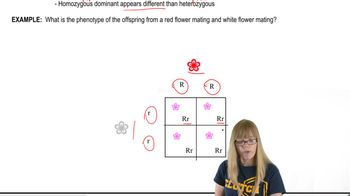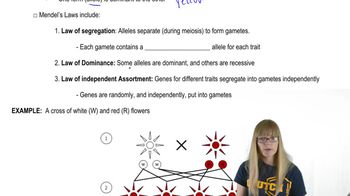Which of the following Mendel's postulates states that alleles separate in the formation of gametes?
Table of contents
- 1. Introduction to Genetics51m
- 2. Mendel's Laws of Inheritance3h 37m
- 3. Extensions to Mendelian Inheritance2h 41m
- 4. Genetic Mapping and Linkage2h 28m
- 5. Genetics of Bacteria and Viruses1h 21m
- 6. Chromosomal Variation1h 48m
- 7. DNA and Chromosome Structure56m
- 8. DNA Replication1h 10m
- 9. Mitosis and Meiosis1h 34m
- 10. Transcription1h 0m
- 11. Translation58m
- 12. Gene Regulation in Prokaryotes1h 19m
- 13. Gene Regulation in Eukaryotes44m
- 14. Genetic Control of Development44m
- 15. Genomes and Genomics1h 50m
- 16. Transposable Elements47m
- 17. Mutation, Repair, and Recombination1h 6m
- 18. Molecular Genetic Tools19m
- 19. Cancer Genetics29m
- 20. Quantitative Genetics1h 26m
- 21. Population Genetics50m
- 22. Evolutionary Genetics29m
2. Mendel's Laws of Inheritance
Mendel's Experiments and Laws
Problem 1
Textbook Question
Describe Mendel's conclusions about how traits are passed from generation to generation.
 Verified step by step guidance
Verified step by step guidance1
Mendel concluded that traits are determined by 'factors' (now known as genes) that are passed from parents to offspring. Each individual inherits two factors for each trait, one from each parent.
He proposed the Law of Segregation, which states that during the formation of gametes (sperm and egg), the two factors for a trait separate, so each gamete carries only one factor for each trait.
Mendel also formulated the Law of Independent Assortment, which states that factors for different traits are distributed to gametes independently of one another, provided the genes are on different chromosomes or far apart on the same chromosome.
He observed that some traits are dominant and mask the expression of other traits, which are recessive. This explains why certain traits appear in one generation but not in another.
Mendel's experiments with pea plants demonstrated that the inheritance of traits follows predictable patterns, laying the foundation for modern genetics.
 Verified video answer for a similar problem:
Verified video answer for a similar problem:This video solution was recommended by our tutors as helpful for the problem above
Video duration:
2mPlay a video:
Was this helpful?
Key Concepts
Here are the essential concepts you must grasp in order to answer the question correctly.
Mendelian Inheritance
Mendelian inheritance refers to the principles of heredity established by Gregor Mendel through his experiments with pea plants. He discovered that traits are inherited in discrete units, now known as genes, and that these traits segregate independently during gamete formation. This foundational concept laid the groundwork for modern genetics, explaining how traits are passed from parents to offspring.
Recommended video:
Guided course

Organelle Inheritance
Dominant and Recessive Traits
In Mendel's studies, he identified that some traits are dominant while others are recessive. A dominant trait will manifest in the phenotype even if only one copy of the gene is present, while a recessive trait requires two copies to be expressed. This concept is crucial for understanding how traits can skip generations and how they can be expressed in offspring.
Recommended video:
Guided course

Variations on Dominance
Law of Segregation
The Law of Segregation is one of Mendel's key principles, stating that during the formation of gametes, the two alleles for a trait separate so that each gamete carries only one allele. This explains the random assortment of alleles during reproduction and is fundamental to predicting the genetic makeup of offspring based on parental genotypes.
Recommended video:
Guided course

Mendel's Laws
Related Videos
Related Practice
Multiple Choice
1085
views
10
rank


